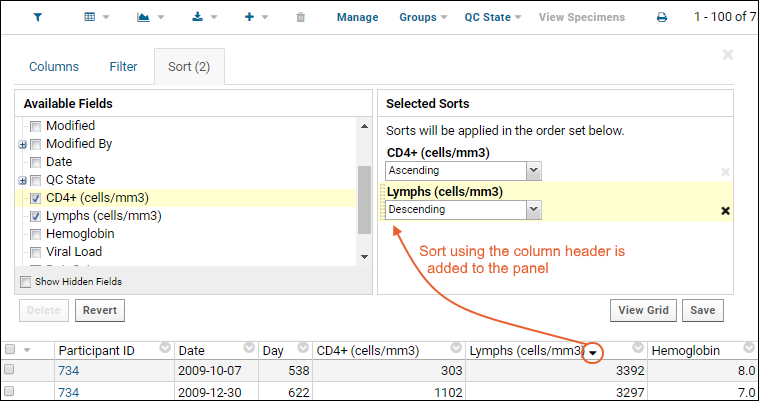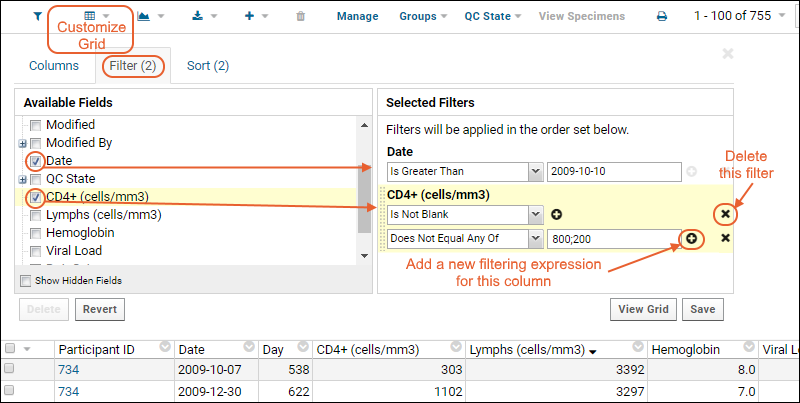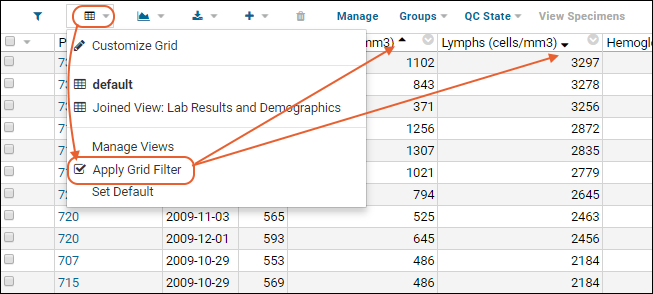When you are looking at a data grid, you can
sort and
filter the data as you wish, but those sorts and filters only persist for your current session on that page. Using the
.lastFilter parameter on the URL can preserve the last filter, but otherwise these sorts and filters are temporary.
To create a persistent filter or sort, you can save it as part of a custom grid view. Users with the "Editor" or "Shared View Editor" role (or higher) can share saved grids with other users, including the saved filters and sorts.
Learn the basics of customizing and saving grid views in this topic:
Define a Saved Sort
- Navigate to the grid you'd like to modify.
- Select (Grid Views) > Customize Grid
- Click the Sort tab.
- Check a box in the Available Fields panel to add a sort on that field.
- In the Selected Sorts panel, specify whether the sort order should be ascending or descending for each sort applied.
- Click Save.

- You may save as a new named grid view or as the default.
- If you have sufficient permissions, you will also have the option to make it available to all users.
You can also create a saved sort by first sorting your grid directly using the column headers, then opening the grid customizer panel to convert the local sort to a saved one.
- In the grid view with the saved sort applied above, sort on a second column, in this example we chose 'Lymphs'.
- Open (Grid Views) > Customize Grid.
- Click the Sort tab. Note that it shows (2), meaning two sorts are now defined. Until you save the grid view with this additional sort included, it will remain temporary, as sorts usually are.

- Drag and drop if you want to change the order in which sorts are applied.
- Remember to Save your grid to save the additional sort.
Define a Saved Filter
The process for defining saved filters is very similar. You can filter locally first or directly define saved filters.
- An important advantage of using the saved filters interface is that when filtering locally, you are limited to two filters on a given column. Saved filters may include any number of separate filtering expressions for a given column, which are all ANDed together.
- Another advantage is that there are some additional filtering expressions available here that are not available in the column header filter dialog.
- For example, you can filter by relative dates using -#d syntax (# days ago) or #d (# days from now) using the grid customizer but not using the column header.
- Select (Grid Views) > Customize Grid.
- Click the Filter tab.
- In the left panel, check boxes for the column(s) on which you want to filter.
- Drag and drop filters in the right panel to change the filtering order.
- In the right panel, specify filtering expressions for each selected column. Use pulldowns and value entry fields to set expressions, add more using the (Add) buttons.
- Use the buttons to delete individual filtering expressions.

- Save the grid, selecting whether to make it available to other users.
Apply Grid Filter
When viewing a data grid, you can enable and disable
all saved filters and sorts using the
Apply Grid Filter checkbox in the
(Grid Views) menu. All defined filters and sorts are applied at once using this checkbox - you cannot pick and choose which to apply. If this menu option is not available, no saved filters or sorts have been defined.

Note that clearing the saved filters and sorts by unchecking this box does not change how they are saved, it only clears them for the current user and session.
Interactions Among Filters and Sorts
Users can still perform their own sorting and filtering as usual when looking at a grid that already has a saved sort or filter applied.
- Sorting: Sorting a grid view while you are looking at it overrides any saved sort order. In other words, the saved sort can control how the data is first presented to the user, but the user can re-sort any way they wish.
- Filtering: Filtering a grid view which has one or more saved filters results in combining the sets of filters with an AND. That is, new local filters happen on the already-filtered data. This can result in unexpected results for the user in cases where the saved filter(s) exclude data that they are expecting to see. Note that these saved filters are not listed in the filters bar above the data grid, but they can all be disabled by unchecking the (Grid Views) > Apply View Filter checkbox.
Related Topics
